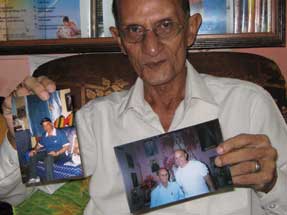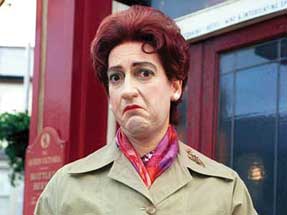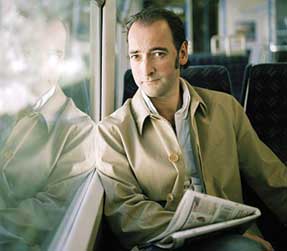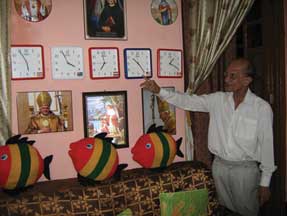Magazine
The Brown Chronicles

Overseas Anglo Indians knock at his door in search of their roots.
|
The famous British comedian Alistair McGowan recently traced his roots back to Calcutta, back to his identity as an Anglo Indian. “Back to” is a wrong way to put it, as he was never really aware of his Anglo Indian roots, which his father hid from him. However, when his father died in 2004, he took his birth certificate to the registrar’s office to apply for his father’s death certificate and was astonished to see the phrase Anglo Indian under caste. McGowan had no idea of what the term meant. Sometime later, he was contacted by the BBC for a series called “Who Do You Think You Are?” and was soon on his way to search for his roots in Kolkata.
The first stop on his search was Melvyn Brown, who has lived in Calcutta all his life and is an important link between Anglo Indians living abroad and in India. As publisher of a monthly newsletter, The Anglo Indians, Brown is known as the “chronicler of the Anglo Indian community,” as for the last three decades he has been trying to preserve the history and culture of the community for future generations. The past decade has witnessed something of a resurgence in the history and identity of the Anglo Indian community, which has its origins in the British Raj. Anglo Indians are the progeny of unions between Indian women and British soldiers, which was encouraged by the colonialists in an effort to create a community they hoped would work as an indigenous support group. Anglo Indians, with their overtly western ways and manners, were never really considered a part of the Indian community and were frequently isolated. Following independence, they were given the option to migrate to the United Kingdom and most left India. The community dispersed all over the world and for reasons ranging from shame, racism and discrimination to plain ignorance about their history, most Anglo Indians hid in closets. Brown says that most Anglo Indians who left for western shores were affluent while those left behind could not afford the move. However, even for them, Britain was always home, even though many had never even visited it. They followed British customs and traditions and thought of themselves as British.
Now, however, many second generations Anglo Indians are unsatisfied with the often-evasive information from their parents about their roots and are desirous of learning more. Meanwhile, in Kolkata, Brown has been busy documenting the history of the community in his six books on the community, newsletter, audio project and through his counseling of the younger generation. Brown says: “Suddenly in the last 10-12 years I noticed that there was a lot of interest in the community from abroad; not only from first and second generation Anglo Indians abroad, but also researchers. Suddenly, the community, which was perceived to be dying, was alive again and I found myself in the center of it. Every day I am inundated with queries about someone’s roots, some people just want to know about the history and culture.” Brown’s newsletter, which he started 30 years ago, has bonded Anglo Indians in India and abroad. It carries listings of birthdays, anniversaries, deaths and news about what is happening in the community worldwide. The newsletter is so intertwined in the lives of overseas Anglo Indians that a woman once called Brown prior to her sister’s operation to ask him to pray for her in his prayer circle with Anglo Indians in Kolkata. After the surgery, she called again to inform him of the surgery’s success. The next month’s newsletter ran her story and encouraged readers to share their trials and tribulations and reach out for support. The July issue carried the obituary of an elderly British woman. It was the easiest way her family could think of conveying the news of her death to all her relatives in India, many of whom they did not even know. “Some of the Anglo Indians abroad keep the newsletter as a status symbol, as a coffee table book for showing off to visitors as something exotic that they receive from Kolkata. Others have a genuine interest in keeping in touch with their roots in Kolkata, keeping in touch with what is happening to their old acquaintances and so on. It is also the easiest way to let friends and relatives know important developments in their lives. It also is a source of information to young Anglo Indians who are searching for their roots. It is often through the newsletter that they come to know of me and seek my help in their quest,” Brown says. On average he receives 6 or 7 genealogical queries every month from people overseas anxious to trace their roots. Of the many requests over the last few months, Brown could assist only eight, because the others did not have much documented information to allow him to research their roots. Of the eight he helped, some were from the U.K., others from Canada and an artist from Japan.
In March 2008, he was contacted by McGowan. He watched McGown’s program on the BBC and realized that they were actually first cousins. Although their families lived in the same country, none was aware of the other’s existence because both families migrated at different times. Once he came to know about the connection, McGowan came to meet Brown to seek out his roots and to confirm his relationship. He recollects his meeting with McGowan: “I told McGowan that to be Anglo Indian does not mean that you were from an English family who ‘happened to be living in India.’ To be Anglo Indian means that a parent was Indian. Not an immediate parent, but someone. The lineage comes down from the mother’s side.” Brown says he told McGowan that it was pretty obvious to his experienced eyes that he was Anglo Indian. “I told him that although I did not know in the beginning that he was an AI, after ten minutes in his company I would have known from his demeanor, manners, diction, vocabulary and his accent.” Brown laughs as he recollects the look of amazement on McGowan’s face. It took McGowan five days to find his roots with the help of Brown during which time he traveled from Allahabad to Mirzapur to Chunar and found that his Anglo Indian roots go back as far as 1750. Another 42-year-old Britisher came to Brown in May in search of his roots. He was born and brought up in the UK and had no idea of his Anglo Indian background, which his family hid from him. When his father died, among the documents he found references to his grandfather in Kolkata. He came to the city and with Brown’s help learnt that his grandfather was a railway guard in the eastern Indian railways. Some Anglo Indians in the twilight of life feel the urge to share their hidden history with their children and grandchildren. Eardley Berkeley from the U.K. sought Brown’s help in developing a detailed report on the history and culture of the community he left behind as a child. Now 62, he wanted to have the information as a legacy for his grandchildren, who are growing up in the West. Wallis Hawes came to Brown from Japan on a similar quest. Jane Smith, a second generation Anglo Indian who lives in London complains that she has no access to her roots: “My mother is so reluctant to talk about her roots in Kolkata that we never talk about it at home. I really want to know about my Anglo Indian roots and to understand my history and culture.”
Smith has visited India many times and came to Kolkata to try to fit the pieces of the puzzle that will give her clues to her background. She is not alone. Many young Anglo Indians in the U.S., Australia, Canada and New Zealand are similarly driven. Thanks to Brown, they now stand a chance to discover that past. For the last four years Brown has been laboriously documenting the community to preserve its history and culture through an Oral History Project he started in 2004. “I had gone to a reception where I heard two old gentlemen talking about their pre-Independence experiences of India. It was so interesting and so many people gathered around him to listen to his account. It just set me thinking that all these will be lost once these people are no more and I thought of documenting these experiences. I thought that here was something live, something people would appreciate in years to come.” Says Brown of his endeavors: “I put a human face on their quest. For me this is a passion and not just a job that I do. I genuinely want all Anglo Indians all over the world to live as a community connected through my newsletter. The global presence of my newsletter has been possible because people understood what I was trying to do. It is for the same reason they come to me, because they know that I have experienced the community. They come to me because I make them feel like they belong.”
|




